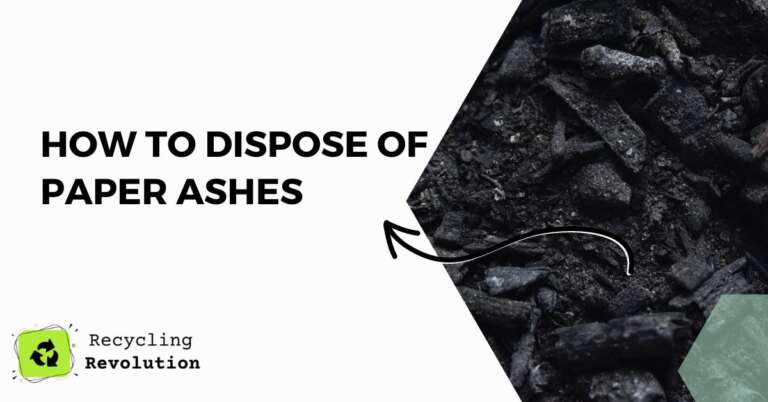Imagine you’ve just enjoyed a cozy evening, burning old documents or papers in your fireplace. What’s left behind? A mound of soft, grey paper ashes. These ashes are the result of complete combustion, a process that reduces paper to its basic components, primarily carbon and trace minerals.
Proper disposal of these paper ashes is crucial, not just for your safety, but also for the well-being of our environment. In this comprehensive guide, we’ll explore the types of paper ashes, the risks of improper disposal, and the most efficient ways to safely dispose of them.
Types of Paper Ashes
Paper ashes can come from various sources. Burnt documents, for instance, often leave behind a lighter ash, while ashes from burnt paper products like paper plates or tissues can be more substantial due to added materials.
Let’s not forget cigarette ashes. Small as they may be, they can accumulate quickly if not regularly cleaned up.
Risks of Improper Disposal
The improper disposal of paper ashes can lead to serious issues. For starters, it can pose fire hazards. If not fully extinguished, hot ashes can ignite a fire, causing damage to property and potentially putting lives at risk.
From a health perspective, airborne ash can lead to health risks such as respiratory problems. Lastly, improper disposal can have a significant environmental impact, harming soil composition and water quality.
Safe Disposal Methods
Fortunately, there are several safe methods for disposing of paper ashes. Firstly, you should always cool ashes completely before disposal. Don’t rush; let the ashes sit overnight to ensure they’re fully extinguished.
Avoid flushing ashes down the toilet; they can solidify and block pipes. Instead, consider disposal in the garbage. Double bag the ashes in durable plastic bags to prevent spillage. Alternatively, burying the ashes can be an effective method, ensuring they are safely returned to the earth.
Recycling Options
While recycling isn’t the first thing that comes to mind when dealing with paper ashes, it’s indeed possible. Recycling burnt paper products can contribute to reducing waste.
You can also get creative with reusing burnt documents. Paper ashes can be used in composting, mixed with paint for unique art projects, or even used in making homemade soap!
Steps for Proper Paper Ash Disposal
To safely and responsibly dispose of paper ashes, follow these steps:
- Wait for the Ashes to Cool down Completely – Before handling paper ashes, ensure that they are entirely cool to the touch. This will prevent accidental burns and help avoid reigniting any hidden embers.
- Use a Metal Container with a Tight-Fitting Lid – Transfer the cooled ashes to a sturdy, non-combustible metal container with a secure lid. This will keep the ashes contained and reduce the risk of a fire.
- Store the Container Outside, Away from Flammable Materials – Keep the metal container outdoors, away from your home, and any flammable materials like dry leaves, wood, or gasoline. This precaution will further minimize the risk of accidental fires.
- Consider Burying the Ashes in Your Garden or Yard – One eco-friendly option for paper ash disposal is to bury them in your garden or yard. This can help enrich the soil and provide nutrients for your plants.
- Avoid Flushing Paper Ashes down the Toilet or Sink – Flushing paper ashes down the toilet or sink can cause plumbing issues and contribute to environmental pollution. Find alternative methods for disposing of your ashes instead.
Disposal Methods
Disposing of Paper Ashes in the Trash
Properly disposing of paper ashes in the trash is a straightforward method, but it requires some precautions. Like waiting for it to completely cool down and making sure there are no live embers. If you had a big firepit from the night before then it can last up to 48 hours or more.
Composting Paper Ashes
Composting paper ashes is an environmentally friendly way to recycle this waste material.
- Adds nutrients to your compost.
- Reduces waste sent to the landfill.
How to Compost Paper Ashes
- Ensure ashes are cool and dry.
- Mix ashes with other compostable materials, like leaves and kitchen scraps.
- Turn the compost regularly to aerate and promote decomposition.
Additional Tips
Keep these additional tips in mind when disposing of paper ashes:
- Don’t mix paper ashes with other types of ashes, such as charcoal or wood. Different types of ashes may have different disposal requirements.
- Avoid disposing of paper ashes in plastic containers, as they can melt or ignite, posing a fire hazard.
- Check local regulations for specific disposal guidelines. Different areas may have varying rules for ash disposal, so it’s crucial to stay informed and follow the guidelines.
Conclusion
Disposing of paper ashes the right way is essential for keeping our environment clean and safe. By following the steps and tips outlined in this article, you can contribute to a more sustainable future and reduce the risk of fire hazards. Remember to stay informed about your local regulations.
FAQ
What can I do with paper ashes?
Paper ashes can be reused in many creative ways. They can be added to compost, used as a component in creating art or homemade soap, or even used as a pest repellent in your garden.
How do you get rid of ash?
Ash can be safely disposed of by cooling it completely, bagging it securely, and placing it in your regular garbage. Alternatively, you could also bury the ash in your garden.
Can you put ash in a compost bin?
Yes, paper ashes can be added to a compost bin. They are rich in minerals that can benefit your compost, but remember to use them sparingly to maintain a balanced compost pile.
What to do with ashes after burning?
After burning, ensure the ashes are completely cooled. They can then be bagged and disposed of in your regular garbage, buried in your garden, or even used in

